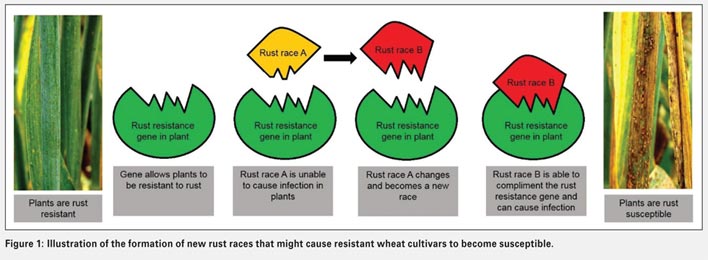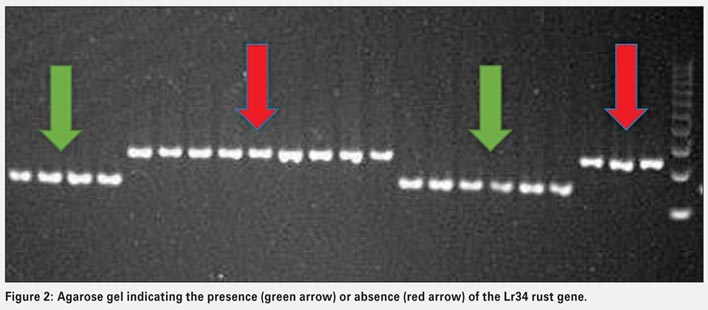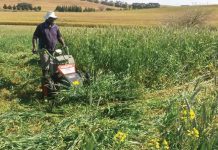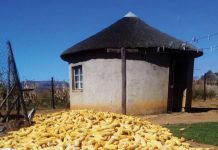September 2015
KRISHNA NAICKER, ARC-Small Grain Institute, Bethlehem
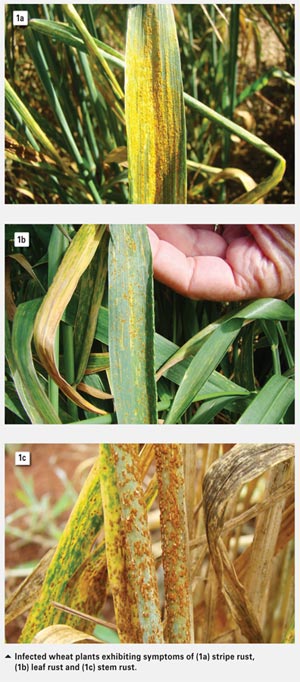 There are three types of rust that infect wheat, and they are stripe, leaf and stem rust (Photo 1a – Photo 1c). The rusts are obligate parasites and cause damage by increasing transpiration and re spiration whilst decreasing photosynthesis.
There are three types of rust that infect wheat, and they are stripe, leaf and stem rust (Photo 1a – Photo 1c). The rusts are obligate parasites and cause damage by increasing transpiration and re spiration whilst decreasing photosynthesis.
Wheat rusts, like most fungi, require free water or moisture in order for the spores to germinate and cause infection. The incidences of the three rusts are dependent on climatic conditions and can vary between seasons. Currently, stripe rust is the most problematic in the summer rainfall area, whilst all three rusts affect wheat production in the winter rainfall area.
South African wheat producers currently rely predominantly on the use of fungicides to control wheat rusts. Fungicide applications may be required more than once in a season depending on the severity of rust infections.
Besides the negative implications that fungicides have on the environment, a reduction in fungicide usage will allow producers to reduce their input costs resulting in higher profits. The constant use of fungicides may potentially cause rust pathogens to develop resistance to fungicides in the future.
The use of genetic resistance is an alternative method for rust control and is overall beneficial to both the environment and producers.
Understanding host plant resistance
There are two modes of resistance that can be categorised as race-specific resistance and adult plant resistance. Race-specific resistance is also referred to as seedling resistance and this type of resistance is generally effective at all plant growth stages.
Resistance is conferred by major genes that offer complete resistance to specific rust races and if not deployed strategically, it can result in the gene being effective for a limited time only, due to the formation of new rust races (Figure 1).
New rust races may occur through mutation or introduction from a different area or country and can result in resistant cultivars becoming susceptible. Adult plant resistance offers partial resistance against most races and functions mainly at the adult stage.
Seedlings are therefore still susceptible to rust infections. This type of resistance is based on complex systems resulting in durable resistance that is much longer lasting.
Breeding for rust resistance
A strategy that is currently used by many breeding programmes is to target the deployment of adult plant resistance in combination with race-specific genes in an endeavour to secure long lasting durable resistance against wheat rusts.
Practically this can be challenging as some rust resistance genes are sometimes located near/close to yield and quality genes, thus negatively affecting yield and quality. This is further complicated by stacking multiple rust resistance genes to ensure durable and effective rust resistance at all plant growth stages.
Releasing wheat cultivars with multiple genes is important in order to ensure that if the pathogen is able to overcome the resistance of one gene, there are “back up” genes that will still offer some level of resistance.
The use of marker assisted selection (MAS) is a significant tool that assists in the combining of multiple rust resistance genes. An advantage of this technology is the ability to develop material with different desired genes in a shorter period of time compared to traditional breeding methods.
MAS is a selection process whereby plants can be identified and selected using molecular markers to validate the presence of specific genes or gene combinations, provided that molecular markers are available for the gene of interest.
Leaf material is harvested from the target plants, DNA is extracted and the samples undergo a polymerase chain reaction (PCR) with specific molecular markers. Using an agarose gel system, PCR product bands will indicate the presence or absence of the target gene. Figure 2 is a picture of an agarose gel that contains samples to be tested for the presence of the leaf rust gene Lr34. From this gel, it can be identified which of the samples contain the Lr34 gene and similarly, the samples can be tested for a wide range of other genes which the plants may contain.
Rust resistant cultivars are your friends…
Take advantage of them
The use of broad-spectrum/durable rust resistance remains the most effective and sustainable strategy to control wheat rusts. The emergence of new rust strains is a threat to existing resistant wheat cultivars and there is a constant need for new sources of rust resistance and experimentation with different gene combinations to prolong the durability of existing resistance sources.
The use of rust resistant cultivars can reduce the negative impact of fungicides on the environment and may also be economically beneficial to wheat producers. Sometimes, planting a rust resistant cultivar with a lower yield potential may result in higher profits compared to planting a higher yielding rust susceptible cultivar that will require several fungicide applications in the season.
 Rust resistant wheat cultivars for the different wheat production areas can be identified and selected from the annual production guidelines released by the ARC-Small Grain Institute (ARC-SGI) and are available on the website www.arc.agric.za.
Rust resistant wheat cultivars for the different wheat production areas can be identified and selected from the annual production guidelines released by the ARC-Small Grain Institute (ARC-SGI) and are available on the website www.arc.agric.za.
Contact Krishna Naicker at 058 307 3436 or NaickerK@arc.agric.za.
This research was made possible with the financial assistance of the
Agricultural Research Council and the Winter Cereals Trust.
Publication: September 2015
Section: Focus on




